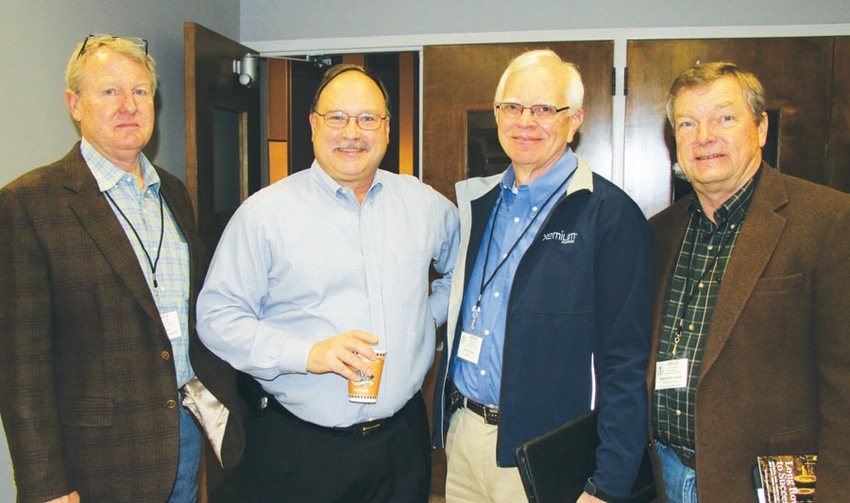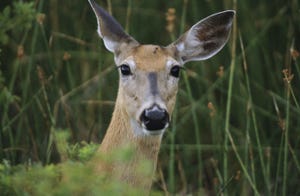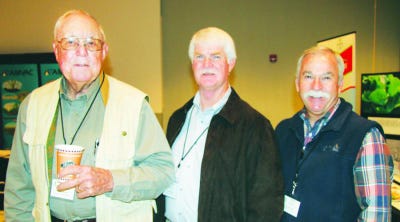
Five million pounds of plant biomass — that’s about how much Mississippi’s 1.75 million to 1.9 million deer eat in a day.
And in agricultural areas a goodly chunk of that consumption consists of soybean plants, says Bronson Strickland, associate Extension professor with the Mississippi State University Department of Wildlife, Fisheries, and Aquaculture.
“It’s no secret that deer love soybeans, and the impact on the state’s agriculture is significant,” he said at the annual meeting of the Mississippi Agricultural Consultants Association. “Anywhere there is a soybean field and there are deer within walking distance, you’re going to have feeding. Even where the deer population is small, there may still be damage.

“IF THERE’S ANY PLANT that’s designed for deer to love and to thrive on, it’s soybeans.
“Soybeans are the perfect deer food — there’s nothing better than soybean plants from the standpoint of palatability, digestibility, and food protein. If there is any plant that’s designed for deer to love and to thrive on, it’s soybeans. For those who want to cultivate a deer population, there’s nothing better for food plots than soybeans.
“With the deer population we have in Mississippi, with each animal consuming an average of 432 pounds of forage over the growing season, it affects which trees survive and grow, what plants grow in our forest understory, the composition of the overall plant spectrum. If you have 20, 30, 50, or more deer browsing in a soybean field, there’s a tremendous impact on the potential production of that field.”

BRONSON STRICKLAND
Losses could be even greater than these estimates, he says, because there has been no definitive research on the extent of the problem.
Strickland, along with Steve Demarais, professor of wildlife management; Tom Eubank, assistant Extension/research professor at the Delta Research and Extension Center; and graduate student Caleb Hinton, will soon start the second season of a study funded by the Mississippi Soybean Promotion Board aimed at developing a comprehensive picture of soybean losses to deer.
“What we’re trying to determine is how we can manage and minimize the damage they cause to agriculture,” Strickland says.
There are, he notes, divergent viewpoints about the state’s deer, even among farmers, many of whom are themselves hunters and/or derive income from deer hunts on their land.
“There are some who look at it from another angle —soybeans mean big antlers on deer. It’s no coincidence that in Iowa, Illinois, or other states with huge soybean acreages they grow a lot of big deer. It’s also no coincidence that deer in the Mississippi Delta are bigger than those in south Mississippi. A lot of that’s due to the easy access to soybeans and the good dirt that’s growing those soybeans. The nutrition provided by soybeans also has a big impact on the fertility of does and the survival of fawns.”
Deer also generate revenue
Strickland says deer represent an $860 million annual economic engine for Mississippi — hunting licenses, equipment, hunting leases, etc.
The Mississippi study, he says, is designed to estimate where in fields deer damage is occurring and how it changes over time.
“Soybean field size is a factor. If a field is large enough, deer damage is spread over more acres and is proportionally less than for a small field.
“Another consideration is, how many mouths are you feeding? In past studies of deer damage to soybeans, one thing that was never quantified is how many deer are causing the damage at the field level? They’ve tried to estimate populations from helicopter surveys, photo surveys, spotlight surveys, etc., but they were estimating the population over thousands of acres.
“We want to quantify the relationship between soybean damage and the number of deer eating beans in a particular field. Secondarily, we want to determine how the number of deer relate to the size of the field, how far into the field damage occurs, how much damage occurs at various spots, the impact of surrounding landscape characteristics, and whether we can use NDVI (normalized difference vegetation index) satellite imagery to help us make decisions rather than having to go out and make visual observations.”

HOMER WILSON, from left, Wilson Ag Service, Fulton, Miss.; Taylor Riddick, Helena Chemical Company, Batesville, Miss.; and Steve McPeek, Bayer CropScience, Clinton, Miss., were taking a break at the consultants annual meeting.
What’s unique about this project, Strickland says, is that “We’re actually counting the number of deer browsing in each field, using infrared devices that detect the deer heat signature. Student technicians sit in the study fields from sundown until midnight, continually sweeping the fields with the infrared devices and counting the number of deer. The deer stand out like a sore thumb. It’s also easy to distinguish the difference between deer and feral pigs, which also cause significant soybean damage in many areas of the state — a pig never lifts its head up.”
The study also is examining how deer impact varies from the field border to the middle of the field. “We do this by establishing protected areas all the way from the edge of the field to the center, then comparing those with the unprotected areas, and correlating those data with how browsing levels vary through the field. We’re also looking at the impact of surrounding habitat on damage within the field.
“We’re measuring plant height, growth stage, and browse counts — number of plants, number browsed/not browsed, number of leaves, and other information. We’re doing this every week in early season and every two weeks later in the season. We also collect plant matter during the season and yield data at the end of the season. All this involves thousands of data points, and a tremendous amount of data to analyze.”
If deer eat small soybean plants, they usually don’t recover and that yield potential is lost, Strickland notes. In other cases, deer just crop the top of the plants. Even late in the growing season, deer damage to soybean plants was still being seen.
Research in Maryland, he says, showed that in a few situations, deer browsing actually improved soybean yields. “They were cropping just enough off the plants to cause more branching, in turn resulting in more beans produced. But I don’t think many farmers would want to count on that happening.”
Some pilot work is also being done on the effectiveness of Hinder repellent, he says, including the number of applications required for different deer densities.
“Sometimes repellents are effective, sometimes not — again it depends on the number of deer and field size.”
Depredation permits are another option for deer control, Strickland says. ‘In some cases, this is absolutely warranted; in other cases, it may not be worth it. It depends on the extent of the damage.”
You might also like:
First-day corn planting always a challenge
Lawsuit could limit fertilizer applications
Irrigation scheduling tools to cut water use
About the Author(s)
You May Also Like




